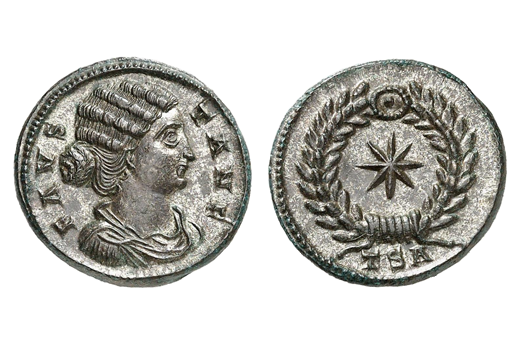
about ancient nomos
Ancient Nomos Art is a museum of galleries exhibiting ancient coins and ancient mint maps. The coin gallery displays the diverse art and history of hand-crafted ancient Greek, Roman, Byzantine, Persian and Medieval coinage. The ancient mints mapping gallery features Greek, Roman, Byzantine, Asia Minor and Medieval mint city regions and territories. Visitor's are welcome to explore, study and enjoy Ancient Nomos Art.

Imperial, Roman – 318 AD
Empress Fausta
From Ancient Galleries

Obverse: Draped bust of Empress Fausta facing right with hair in a small bun.
Reverse: Central eight-rayed star in large laurel wreath with ribbons and jewel.
LEGEND
Obv: FAVS TA N F, draped bust of Empress Fausta facing right with hair in a bun. Rev: Eight-rayed star within laurel wreath with ribbon below and large central jewel above; TSA in exergue.
This truly exceptional follis of Empress Fausta commenced under Constantine the Great with both her and her mother-in-law Helena’s elevation to imperial status in 318 AD. Thus began a truly remarkable series of maternal coinage struck at the Thessalonica mint on which daughter-in-law Fausta and Helena are accorded the new title of Nobilissima Femina (see ‘NF’ in the obverse legend). Both women were accorded rank of Nobilissima Femina for a considerable time, Helena since Constantine the Great’s elevation to imperial status in 306 AD, and Fausta since her marriage to Constantine in March of the following year. The significance of this anepigraphic reverse remains uncertain, though it presumably contains some reference to their royal status, divine providence and future destiny. Empress Fausta was held in high esteem by Constantine, and proof of his favor was that in 324 AD she was proclaimed Augusta; previously she held the title of Nobilissima Femina. Ironically, future destiny did not bode well for in 326 AD, Fausta was put to death by Constantine. Fausta’s death followed that of the execution of Crispus, the eldest son of Constantine by mistress Minervina. The two deaths have been linked in various ways. It has been suggested that Fausta was either jealous of Crispus, as noted in the anonymous Epitome de Caesaribus, perhaps because her stepson, who was much closer to her in age, was engaging in an adulterous affair with the Empress. According to the Latin Epitome de Caesaribus by Photius, Fausta was executed by being lowered into a bath of boiling water. However, David Woods offers an alternate theory by making a connection of overheated bathing water as the contemporaneous technique of administering an abortion, perhaps a suggestion that implies the termination of an adulterous pregnancy. Following the deaths, Constantine ordered the Roman ‘damnatio memoriae’ of his wife, resulting in the absence of contemporary source materials, evidence or records detailing the precise fate of Fausta. Eusebius fails to mention neither Crispus nor Fausta in his Life of Constantine, and even wrote Crispus out of the final version of his Ecclesiastical History (HE X.9.4)”, notes Constantine’s biographer Paul Stephenson.
DOCUMENTATION
Value: Follis. Metal: AE Bronze. Weight: 3.37 grams. Mint: Thessalonica. Struck AD 318-319.
Attribution: Roman Imperial Coinage, VII, 49 page 504; LRBC 824.
Legend, Documentation and Attribution
